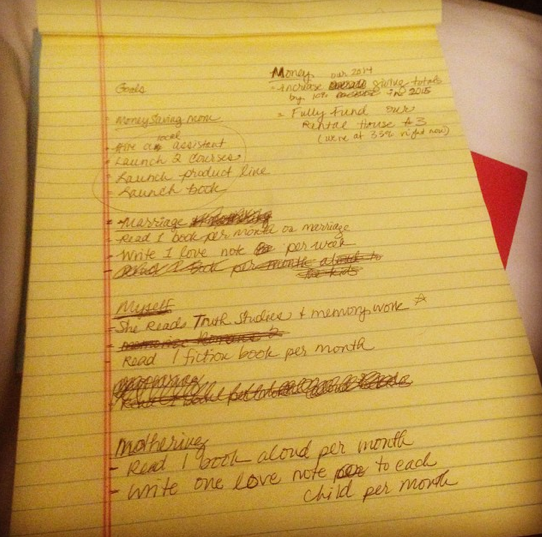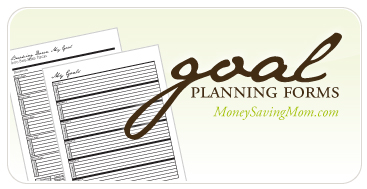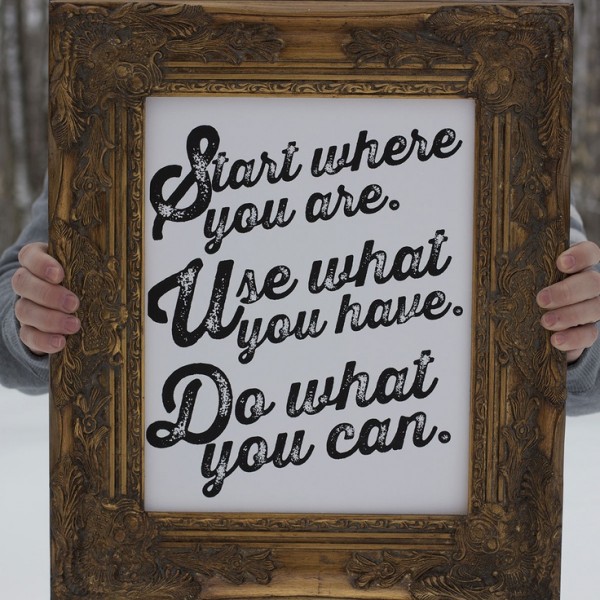
For 15 days, we’re exploring the topic of making our health and well-being a priority as part of the 15 Days to a Healthier You series. You can read Day 1 here, Day 2 here, Day 3 here, Day 4 here, and Day 5 here.
I believe one of the biggest reasons people don’t get where they hope to go — or don’t really get anywhere in life! — is because they don’t set goals. Goals bridge the gap between dreams and reality.
It’s fairly easy to brainstorm. It’s very easy to day dream. It’s hard to get on your work clothes and get busy. But if you don’t know where you’re going in the first place, it’s almost guaranteed you’re never going to make it there.
If you always do what you’ve always done, you’ll get what you’ve always gotten. You have to change something if you want to see change.
Yesterday, we took some time to talk about three Do’s and Don’t’s that I believe are imperative to lay the foundation for successful goal-setting. Now that we’ve laid that foundation, I want to walk you through some simple steps to successful goal-setting:
1. Jot Down ALL Your Ideas
Over the course of the next 24 hours, start jotting down every goal idea that pops into your head that you’d really like to tackle soon. Whether it’s a project you want to work on, a skill you want to learn, a fitness goal, a weight-loss goal, a desire to change your eating, the fact that you want to get more sleep, a financial milestone you want to hit, something you’d like to accomplish… there are no wrong answers!
If you’re anything like me, your list of ideas will probably be very long. This is completely okay! Don’t let it freak you out or make you hyperventilate. You’re just brainstorming to help you narrow down and prioritize your goals list.
The more ideas you have, the more you have to work with and streamline. So don’t hold back; write everything down that comes to mind!

2. Prioritize Your List.
Once you’ve come up with (probably) an extensive list, go over it carefully and thoughtfully considering which items on the list are really going to make a specific and near-immediate impact upon your every day life. Always keep in mind first what your priorities are for the season of life that you’re in.
Think specifically through each area of priority in your life and see what items on your list match up with those priorities and which can be instantly discarded. As you contemplate your list of ideas in light of your priorities, it might also cause you to come up with other ideas you need to add to your list. If that happens, then go ahead and add those items and go back to prioritizing your list.
3. Pare Down Your List.
After you’ve prioritized the list, pare that list down to the top two or three. If this is a struggle for you, step back and try to think of how each goal will directly your life.
Thinking things through to the direct effects over the course of the next few months usually is all it takes for me to prioritize and decide upon the most important priorities.
For instance, learning to make Artisan Bread is something I really, really want to do someday (along with about 50039 other things!), and it would be a fun idea to pursue at some time, but it’s not in line with my current priorities so I would pare it immediately off the list.
But making time to exercise is something that is high on my list of goals because it directly and positively impacts all four of my main priorities in life right now — it helps me stay healthier (priority: myself), it gives me more energy to be a better mom (priority: motherhood), it helps me be more creative and focused as a business owner (priority: MoneySavingMom.com), and it’s something I love getting to do with my husband every day (priority: marriage).
Not all items on your list need to positively impact all your priorities, but you had better be able to make a really strong case for how an item is going to majorly impact at least one of your priorities for it to stay on your list. I encourage you to pare down your list to 2-4 items that you feel will make the greatest overall impact on your priorities in the season of life you’re in.
Free Printable Goal-Setting Worksheets
To help you out, here are two printable and customizable Goal Planning Forms you can download, type into, save, and print. Or, you can just print them and hand write your goals in.
4. Define your 2-4 specific, detailed, and actionable goals.
Once you have your list of the top 2-4 items you want to focus on, then it’s time to create specific, detailed, actionable goals for that focus area.
For instance, if you want to focus on getting in a better financial position, maybe you decide you want to set a goal to save a specific amount of money, or have a goal to set up your retirement accounts this year, or to read books at least 5 books on improving your financial situation, or to go through Financial Peace University, or to start a frugal friends group.
Each of these is a specific, detailed, actionable goal with a start and end date. You will know when you have accomplished the goal. That’s what makes it a goal in the first place. If your is not detailed and actionable enough to know when it is accomplished, then you need to go back to the drawing board and refine it until you get there.
5. Create your plan of action.
After you’ve defined your goal, then create a specific plan for how it’s actually going to happen. Otherwise, it will just be a good idea that never goes anywhere!
For instance, if you want to read 5 books on getting handle on your finances, you need to choose the five books, figure out when you’ll fit in reading into your schedule, and then set a goal for how much you’ll read every week.
As I just did there, I highly recommend that you break your goals down into bite-sized pieces. A big goal can seem overwhelming and daunting as a whole, but when broken down into small pieces, it becomes much more doable.
If one of the save up a specific amount of money, break it down into monthly and then weekly savings goals. Look at your budget and decide where you’re going to come up with the extra money. Will you lower your grocery bill by $10 per week and then put that money toward your savings goal? Will you work an extra few hours and save that money toward your goal?
When you break your goal down to a weekly bite-sized piece, you are better able to know exactly what you need to do to stay on track. If you want to read 24 books next year, you know you’ll need to read two books per month, or half a book each week. That boils down to around a chapter per day, give or take. That’s much more concrete and doable than a big audacious goal of reading 24 books in a year.
6. Get Some Accountability.
Want to guarantee you have more success in following through with your goals? You need some accountability!
In our Make Over Your Year course, we recommend that you to set up 3 different forms of accountability:
- A Person: a real-life person or group of people who will keep you accountable and check in on you.
- A Product: an app, a printable, an ebook, or spreadsheet that will help you track your milestones.
- A Party: a plan to celebrate when you reach the milestones you have set up for yourself. This gives you something to look forward to and will keep you going on the hard days.
Setting up multiple forms of accountability, gives you more motivation and it sets up a variety of checks and balances — which will hopefully help you stay on task when you want to quit or get distracted.
Remember: Do What You Can Do and Let Go of What You Can’t Do
We’re all in different seasons and stages of life. We all have different challenges and struggles. Think about your own unique challenges.
Some of you are in school full-time. Some of you work full-time. Some of you have lots of little children. Some of you have a brand-new baby (or twins!). Some of you have health issues.
Some of you are caring for elderly parents or grandparents. Some of you are in the middle of moving cross country. Some of you are dealing with a death of someone you love. Some of you are pregnant or in the middle of adopting. Some of you have children with special needs. Some of you are going through heart-breaking circumstances that many of us can’t even begin to imagine.
No matter your age or stage of life, you have your own set of difficulties and things to juggle. If it’s not something you can change, accept it realizing that what you’re able to accomplish will not be what someone else who is in a different season of life is able to accomplish. And that’s perfectly okay!
I love Teddy Roosevelt’s motto: “Do what you can with what you’ve got where you are.” All we can do is all we can do.
Spending time wishing we were in someone else’s shoes doesn’t change or improve our situation. If you’re in a really busy season of life, you may only be able to devote an extra 10 minutes five times per week to tackling your goals. Don’t be discouraged.
Do what you can do and don’t worry about what you can’t do! Because doing something is almost always better than doing nothing.
Day 6 Project
If you don’t have any specific goals in your life right now, take some time over the next 24 hours to go through the steps outlined above and determine a few simple goals, break them down into bite-sized pieces, and set up some accountability.
If you already have some specific goals, go through the steps above and make sure your goals are in line with your priority, are doable, and that you have a specific plan of action and some accountability in place.
If you are willing, I’d love to hear what a few of your goals are. Share them with us in the comments!
Want Step-By-Step Goal-Setting Help?
Need some encouragement to create realistic goals and follow through with them? Go check out our 4-Week Make Over Your Year Course.
This 4-week course includes a comprehensive downloadable workbook, printable worksheets to walk you step-by-step through the goal-setting process we’ll teach you, additional resources and links for each week, and 4 one-hour-long pre-recorded Group Coaching Sessions taught by my husband and me.
It’s just the gentle kick-in-the-behind you need to actually be successful in goal-setting!
Get Make Over Your Year for just $29 here today!
More Helpful Resources:
- Feeling like a goal-setting failure? Read my posts on Why I Bombed My 2014 Goals and Why You Need to Set Goals According to Your Own Abilities.
- If there’s one key to goal-setting success I can give you, it’s this: Write Down Your Goals. Read more why you should do this here.
- See examples of my Yearly Goals here and My Weekly Goals here.




How would you take a goal like “Get the kids in bed earlier” and make it have a clear endpoint without backtracking? If I say “get the kids in bed by 8:30 every day this week,” then I feel like I did it, but the next week I finished that goal so we slip backwards to a later bedtime. Another one that’s like this for me is keeping toys picked up. How do you define “picked up,” and if you want it to be ongoing, how do you know when you’ve reached it? (Other than realizing, hey! the house doesn’t get as bad as it used to!)
Something that’s been working fairly well for us this year: I’ve been choosing just one area for the kids for an entire month. For example, in January it was putting dirty clothes into the hamper right away. I didn’t worry about any other new habits with them that month (because I knew I’d get to them soon), but we just focus on that one. It’s been working really well! Some of the habits have stuck better than others, but it’s nice to have one clear habit to focus on with them at a time.
Something we did with toys that worked really well was pick specific times to put toys away – after lunch, after dinner, before we leave the house, etc. We also have a table where they can leave a puzzle, craft project, etc. out rather than having laying in the middle of the kitchen table or whatever. When it became automatic we considered it “done”.
We kind of did the same thing with bedtimes – starting the routine at a certain point each evening rather than a specific bedtime. The children were in bed within a 15 minute window and that was good enough for us.
We included each of those as an area to work on each month (I have always loved that idea – it works so well!) rather than having it as a real goal, since it’s not something I have complete control over. For us when the kids started school we spent the first month working really hard on the bedtime routine and the first month in the summer on picking up.
Hope that gives you some ideas!
Lea
Lea,
I love your idea about setting a clean up time and when you clean up at that time, the job is “done.” For me the devil is in the details and knowing when I can really cross the job off as “done” can really leave me with an incomplete feeling (i.e. “is it “really” done?). Also love that the bedtime goal is based on when the bedtime routine starts. Makes so much sense. Thanks for sharing.
Yes, those are great tips! thanks!
I think some goals are easier to define than others. For goals that don’t have such a clear-cut end date and are more ongoing, I find it best to set a time frame goal like you talked about. So, something like, “For the next 21 days, we’ll have the kids in bed by 8:30 p.m.” At our house, if we stick with something for a few weeks, it often seems to become a habit or at least something that happens a lot more often than not.
Thanks! I’ll give it a try 🙂
I love the idea of taking time to jot down ALL your ideas. Would definitely help get them out of my head and see more clearly which ones are actually important to me. This is probably the best post on goal setting you have written, Crystal!
Aw, thank you so much for your kind words, Katie!
I’m a huge goal-setter so this is right up my alley Crystal?
Goal 1: Health- start running again when given the all clear from Doctor (having some postpartum challenges right now ?)and begin Insanity at 8 weeks. We’ve had this DVD set for years and have never done the whole 69 days!
Goal 2: Family – practice more patience, love, and grace towards my 4 year old. Sometimes a hug is better than a raised voice. Be intentional with time I spend with my kids.
Goal 3: Marriage – start scheduling date nights when my 1 month old is more comfortable with the bottle. Or schedule “day-dates” while 4yo is in school and baby can tag along ?
Goal 4: Financial – save all overtime pay for our Christmas/family reunion vacation!
My sister and I will be doing Insaniry together so she’s my accountability there. And my blog will be my accountability on my running and 50 days of Insaniry as well. My hubby is my accountability with our children, marriage, and finances. I e also signed our 4yo up for free summer bowling and soccer in the Fall so the money is kinda my “accountability” if you will – don’t want it to go to waste! Oh and when my sister visits in 4 weeks she’ll hold us accountable to get a date night in!
Hmmm 69 and 50….Insanity is clearly 60 days ?
I don’t do Insanity every day, but I do it a few times a week, and it makes me feel so good! Enjoy!!!
“Sometimes a hug is better than a raised voice.” SUCH a good word!!